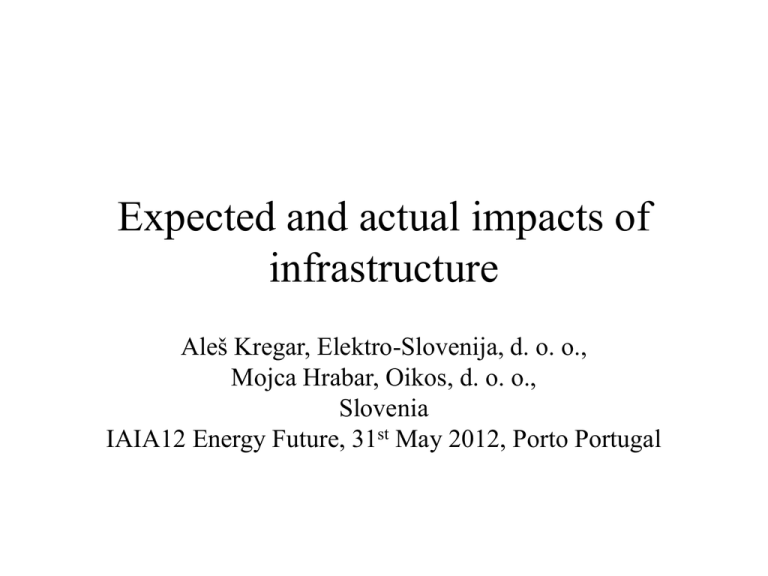Expected and actual impacts of infrastructure
advertisement

Expected and actual impacts of infrastructure Aleš Kregar, Elektro-Slovenija, d. o. o., Mojca Hrabar, Oikos, d. o. o., Slovenia IAIA12 Energy Future, 31st May 2012, Porto Portugal Hypothesis • Impact assessments usually deal only with negative impacts of human interventions • Some human interventions in the environment in the past form valuable and protected habitats today • Nature adjusts to human activities in a relatively short timeperiod • Impact assessments often neglect positive impacts of planned infrastructure in nature 2 Observations from Slovenia • In Slovenia there are different protected areas covering 1/3 of its surface: NATURA 2000, national and local protected areas, ecologically important areas and valuable natural features • Many of them include areas changed by human activities • Some of them are among most valuable habitats for endangered species • Impact assessments usually do not consider positive impacts of infrastructure on nature • Many infrastructure projects have delays because of open issues related to the environment 3 Drava River, included in NATURA 2000 and other protected areas 4 Drava River, 110 kV overhead line crossing artificial Ptuj Lake, part of hydro power plant and one of the most populated areas with water birds and place where many migratory birds rest 5 Sandpit Pleterje near Kidričevo, an ecologically important area and valuable natural features 6 Sandpit Pleterje near Kidričevo, an ecologically important area and valuable natural features 7 Sandpit Dobrovnik near Lendava, an ecologically important area and valuable natural features 8 Sandpit Dobrovnik near Lendava, an ecologically important area and valuable natural features 9 400 kV overhead line Cirkovce-Pince project in Slovenia: (left figure) suggested mitigation measure – compensation habitat for white storks (Ciconia Ciconia); Portugal: (right figure) mitigation measure for same species nesting platform (REN, Sustainability Report 2010) 10 Conclusions • Some observations confirm positive impacts of infrastructure on environment at least on some species or habitats • There are considerable differences in how projects in different countries mitigate the same kinds of impacts • Lack of monitoring of existing infrastructure hinders development of methods and quantification of impacts • Different stakeholders understand the legislative requirements and impact assessment process differently 11 Suggestions: • Impact assessments should be standardised: selection of most suitable methods for quantitative determination of impacts • Selection of comparable mitigation measures for the same infrastructure for the same species (or same habitat) not dependent on the country • Public access to impact assessments reports from different countries • Results of monitoring of existing infrastructure should be considered in impact assessments for upcoming projects • Long term monitoring should be established after a project is implemented 12 Thank you for your attention Additional questions: ales.kregar@eles.si, mojca.hrabar@oikos.si











